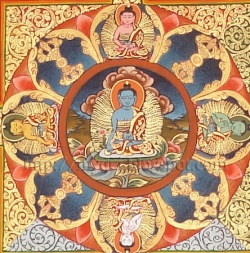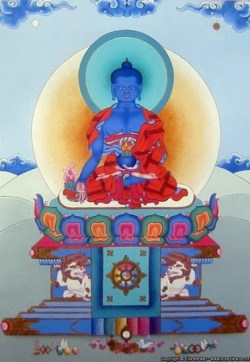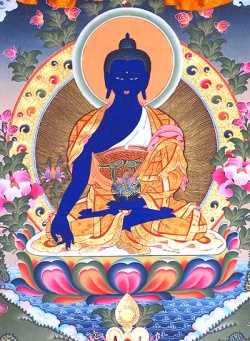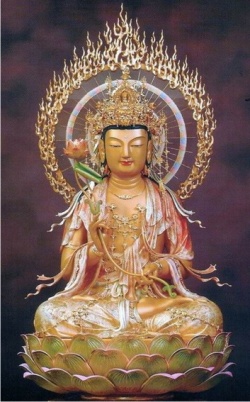The Eight Medicine Buddhist
By Dr.Natalia Bolsokhoyeva
One of unusual but equally well known figure in the Mahayana Buddhism is the Medicine Buddha or the Healing Buddha-Bhaisajya Guru. The cult of the Healing Buddha is popular in all the countries where the Mahayana Buddhism is practiced. In Tibetan medical treatises the epithets of the Healing Buddha are attributed with numerous names: Master of Healing, supreme Physician, Supreme Healer and Physician, The Buddha of Healing. Supreme healer Buddha etc. The main principle of the Healing Buddha like Physical Healing of illnesses, Spiritual Healing of illnesses, Healing of internal and external illnesses is described in the ancient texts of the Mahayana tradition.
The images of Bhaisajyaguru, presiding over the Healing Art, play a special role in the Ritual worship, invocation of the Spiritual Power of the Healing Buddha, prayers and oferings. In various Buddhist Monasteries of China, Tibet, Nepal, Mongolia and Buryatia there are many images of Bhaisajyaguru. The Tibetan paintings scrolls or Thankas as well as the gilt bronze images of the Master of Healing are to be found. The bronze sculptures of the Healing Buddha Bhaisajyaguru are traditionally craftsmanship of the artists from Patan. They are of different period however showing master craftsmanship of the artist from Patan. This tradition is still kept alive in Nepal Today Study of archaeological materials dated of different eras and analyzed by many scholars shows the images of the Healing Buddha that have not yet been discovered in any regions of India. It should be noted here that it is not necessary to discuss toe special popularity of the cult of The Buddha of Healing in India.
In the history of Buddhist Art of the various countries, where Buddhism had spread and practised too there are different traditions of the depictions of the Healing Buddha, In Tibetan paintings the most popular images are the seated images of The Buddha of haling. They are well established iconographic patterns which later on was incorporated into Buddhist Art of Mongolia and Buryatia when Buddhism reached in These areas. The beautiful depictions of Bhisajyaguru, created by great masters are still found in many Buddhist Monasteries of Mongolia and Buryatia.
The exhaustive characteristics of the numerous function of the Medicine Buddhist and his iconography are there in various relevant Tibetan medical texts. Some questions, concerning various aspects of the Healing Buddha and discussed herewith base mainly on both the Tibetan medical treatises and the comprehensive Tibetan sources appertaining to the teachings, Healing principles. Methods and Healing abilities of the Healing Buddha. In this article I have ventured to combine the facts from the most momentous written sources in Tibetan to introduce the valuable Information about various aspects of The Buddha of the Healing. On traditional Tibetan Thankas and a great deal of statues are created by the Tibetan artists from many generations, mainly they are the depictions of the seated Buddha of Healing.
As a rule in the seated images the Healing Buddha holds the Healing fruit-myrobalan (Latin.Terminalia Chebula) in his right hand and Lapislazuli (Skt. vaidurya) (1) bowl of amrt (nectar of immortality divine Healing nectar) in his left hand. According to the Buddhist tradition, they are the symbols of his Healing Power. Myrobalan (Tib: A-ru-ra) affects the Mind as well as the Body. It underlines the nature of The Buddha of Healing. Int he Tibetan medicine Myrobalan is considered as the universal treatment, which may cure all 404 diseases (2), known in the Tibetan clinical medicine. Due to the special nature, potent qualities and Healing properties Myrobalan is used as one of the most important and useful ingredient for the greater number of the Tibetan treatments. Lapislazuli is an unique gemstone, endowed with the potent energies and divine forces, which may benefit and then cure the Body and Mind of living beings. Lapislazuli is considered to have possessed the Healing significance. A Healing Buddha is depicted most commonly with skin of Body and face coloured with the dark bluish of lapislazuli. He enthrones on the lapislazuli's seat and sits in the full Lotus Meditative posture and has one face and two arm. The modern Tibetan artists still follow this tradition.
The standard depiction in the Tibetan traditional Art is the Healing Buddha and his brothers. The term "The Eight Medicine Buddhas" or The Eight Buddha Brothers is the most common in the Tibetan Healing traditions. The depiction of the Eight Healing Buddhas, the eightfold division is not only popular but also favored by the artists in Tibet. The great Tibetan artist while describing the eight Healing Buddhas have created the wonderful painted scrolls, which are the unique creations of the Tibetan arts.
The worship (offerings, praises, prayers, the Ritual hand gestures, recitations of mantras and a great deal of secret formulas, visualization, initiation etc.) of the Eight Healing Buddhas has widespread popularity in the 'Tibetan Buddhism. Thanks to the increasing importance of Healing activity that created the Tibetan of the cult of the Healing Buddhas. These scriptures include the symbolic, Spiritual and physical aspects of the Healing with special references to worship of the Healing Buddha. Some of these significant scriptures are very short and consist of very few pages only.
Some of them are very large and contain a great number of pages. They were completed by different composers and they very popular in the Buddhist practice. The description of the Healing Buddhas is given in the4 text "The abbreviated essence of he Healing Buddha Sutra, entitled "The Wishfulfilling gem" (Tib:sMan bLa'i mDo chog gi snying-pf bsdus-pa yid bzhin norbu zhes bya ba), compiled byShakya shramana Chos Kyi rGyal-mtshan, who delivered the teaching at the school of religious attainments at Tashilhunpo Monastery. (3) This text is included in the second volume of the collection of Buddhist religious works "gZungs-bsdus". It is consisted of the descriptions of the Ritual worship of the Buddhas of Healings; praises, prayers, offerings a complex of the protective dharanis, directed to all human beings for the Protection and Spiritual and physical Purification.
The Eight Healing Buddhas are described based on the text mentioned above.
1. Sangs-rGyas mTshan legs-par yongs bsgrags dpal=mTshun lets youngs bsgrags dpal; (Sky: Buddha Suparikirtitanamashri) His Body is of golden colour.
2. Sgra-dbyangs kyi rgyal-po, (Sky. Buddha Svaraghosa) His Body is of yellow in colour.
3. Sangs-rgyas gser-bsang dri-med rin-chen snangs=gser-bzang dri-med (Skt. Buddha Suvarnabhadra vimalaratnaprabhasa) His Body is of gold in colour.
4. Sangs-rgyas mya-ngan med mchog dpal=mya-ngan med mchog dpal, (Skt. Buddha Ashokattamashri) His Body is of white red in colour.
5. Sangs-rgyas chos bsgrags rgya-mtsho'i dbyangs=chos bsgrags rgya-mtssho'i dbyangs. (Sky. Buddha Dharmakirtisagaraghosa) His Body is of white red in colour.
6. mNgon mKyen rGyal-po. (Skt. Buddha Abhijnaraja) His Body is of coral colour.
7. Sangs-rgyas sMan gyi Vaidurya'i od kyi rgyal-po=sMan-po'i rgyal; (Skt Buddha Bhisajyaguru vaiduryaprabharaja) His Body is of Lapislazuli colour.
8. Sangs-rgyas dpal rgyal-ba Sahkya thub-pa (Skt. Buddha Shrijing Shakyamuni..) His Body is of golden colour.
According to this text Shakyamuni Buddha is one of the Eight Medicine Buddhas. HE plays the role of "Supreme Physician" or as "Supreme Healer" or "The King of Medicine". he heals the living beings in thius World; cures any physical diseases and Affliction, due to his special Healing potency, energy and powerful medical techniques. His effective Healing methods with profound Blessings benefit the people. Hence Shakyamuni Buddha is presented among the eight Healing Buddhas. He is traditionally depicted above the head of the Medicine Buddha-Bhaisajyaguru. He is considered to be the great healer because of his supremely effective Healing and the Healing Meditation technique taught to his disciples.
In the Tibetan Medical tradition the text entitled "The collection of offerings to the Seven Buddhas, has also the title "The Fabulous Wishfulfilling Gem" (Tib: bDer gshegs bdun gyi mchod-pa'i chog sgugs yid bzhin dbang rgyal zhes bya ba bzhuga so). As it is apparent for the title of this scripture, it may be concluded that the worship of the Seven Buddhas have immense significances. Analysis of this text shows, that it contains the complete Ritual worship of the Eight Healing Buddhas. In the text there are the description of the features of each of the Healing Buddha with an indication of their typical functions. This scripture underlines the popularity of the cult of the Healing Buddhas and the great importance of the medical Healing, abilities and activities. With the special but profound Healing techniques, benediction and words of Blessings the a Healing Buddhas achieved great success in the curing of a great variety of illnesses of all living beings by means of medical plants, excellent medical herbs and Food, a great member of other remedial and unremedial methods. The text, mentioned above, is the fundamental for special Puja, directed for physical and Spiritual Healing of physical sicknesses and the Healing of internal and external ailments.
Quite often in Buddhist practice this text is used to heal the serious illnesses of the living beings in this World. The unbroken lineage of the powerful and profound Healing methods was introduced by Shakyamuni Buddha himself in this World. He delivered his profound Healing to his main disciples. These teachings were transmitted from one generation to another.
Notes
1. There are different points of view about the meaning of Sanskrit Vaidurya
Based on the depiction of the Mandala of Medicine Buddha (the first table of "The Atlas of Tibetan Medicine" from historical Museum of Ulan-Ude. Buryatia, Russia), where the central figure is Gnaisajyaguru, holding the bowl of the dark blue colour in his left hand, I have translated Vaidurya into Lapislazuli. It should be noted that there are numerous evidences that Vaidurya might have different colous; For example, it the titles of the treatise, concerning the key problems of the Tibetan traditional sciences composed by prominent and vesatile Buddhist scholar of medieval Tibet: Desi Sangs-rgyas rGya-mtsho (1653-1705), we find that "Vaidurya dKar po I( WhiteVaidurya), Vaidurya sNgon-po (Blue Vaidurya i.e lapislazuli) and Vaidurya ser-po (Yellow Vaidurya). It seems thus that Vaidurya sNgon-po, included in the title of the most profound commentary on the fundamental text of the Tibetan medicine "rGyu-bgZhi", should have the important distinction, divine substance and Spiritual forces. It is considered as Symbol of Healing Art. It is possible to assume that the existence of Vaidurya of the various colous lies at the base of the translation of Vaidurya, as glass, crystal, bery, lapislazuli.
2. The 404 diseases are the result of imbalances of three humours (wind,bile and phlegs); according to Tibetan medicine the Body is dominated by these three humours.
3. Tashilhupo Monastery is one of the most powerful and Spiritual city in our World, It is situated in Shigatse, the second largest city in Tibet. By tradition, this Monastery is the seat of the Panchen Lamas, the emanations of Long Life Buddhas.



